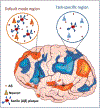Amyloid by default
- PMID: 21613991
- PMCID: PMC10715806
- DOI: 10.1038/nn.2853
Amyloid by default
Abstract
The sustained metabolic activation of the brain’s default-mode network is thought to render the system vulnerable to Alzheimer’s disease. Recent results with transgenic mice support this view by linking neuronal activity to interstitial fluid amyloid-β levels and the development of amyloid-β plaques.
Figures

Comment on
-
Neuronal activity regulates the regional vulnerability to amyloid-β deposition.Nat Neurosci. 2011 Jun;14(6):750-6. doi: 10.1038/nn.2801. Epub 2011 May 1. Nat Neurosci. 2011. PMID: 21532579 Free PMC article.
References
Publication types
MeSH terms
Substances
Grants and funding
LinkOut - more resources
Full Text Sources
Medical

